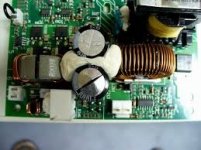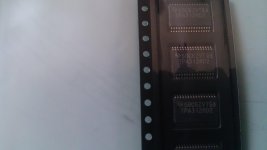OK, first is clear.
Still struggling a little with colours and schematic, but the red is 470pf, just -1dB at 20kHz, for audio not very important probably and the little more dB's help at filterfrequency ? If computer/source injects a little for example ?
Why does TI when gaincompensation is needed go back towards the 22p (100p) ?
Still struggling a little with colours and schematic, but the red is 470pf, just -1dB at 20kHz, for audio not very important probably and the little more dB's help at filterfrequency ? If computer/source injects a little for example ?
Why does TI when gaincompensation is needed go back towards the 22p (100p) ?
for audio not very important probably and the little more dB's help at filterfrequency ?
What are you trying to say?
Why does TI when gaincompensation is needed go back towards the 22p (100p) ?
Commas would really help to understand you. Did you meant
Why does TI, when gaincompensation is needed, go back towards the 22p (100p) ?
?
Because they don't limit the bandwidth.
So TI doesn't seem very consistant to me, first limitting bandwidth a little, when adding pffb, changing 22p to 330p, then later reversing that, 330p to 100p, when gaincompensation is asked for.
In your schematic model, the 330p to ground before tpachip, that is the evm's 100p plus inputcapacitance tpachip, or is it also added filtering ?
In your schematic model, the 330p to ground before tpachip, that is the evm's 100p plus inputcapacitance tpachip, or is it also added filtering ?
It depends on the input-stage gain. YMMV, best to measure and adjust.So TI doesn't seem very consistant to me, first limitting bandwidth a little, when adding pffb, changing 22p to 330p, then later reversing that, 330p to 100p, when gaincompensation is asked for.
It's HF-filtering.In your schematic model, the 330p to ground before tpachip, that is the evm's 100p plus inputcapacitance tpachip, or is it also added filtering ?
Last edited:
Your speaker in sim is very close to Alpair 10, a complete speakerzobel would be like 1uF and 9 ohm. Probably better to not try to make an ampboard for 4 ohm resistor, but more towards the 6 ohm outputfilter "average" tpa3116/18 already use standard ?
It probably isn't because btl equivalent of 8 ohm single ended would be a 16 ohm speaker, that would be more like a Lowther exotic.
Chocoholic used 15uH/0.77uF (385kHz fsw) single ended filter with smaller zobel 0.33uF/2.2 ohm (3 watt), so he also seemed to use low speaker impedance as basis, mmm.
Chocoholic used 15uH/0.77uF (385kHz fsw) single ended filter with smaller zobel 0.33uF/2.2 ohm (3 watt), so he also seemed to use low speaker impedance as basis, mmm.
Also here on diyaudio, B&O zobel 200w amp, over load. (I believe Icepower is like BD modulation). +1dB at 50kHz open load, 4th order filter though ?
http://www.diyaudio.com/forums/attachments/class-d/144327d1256240866-sanyo-b-o-icepower-200ac-rev-d-schematic-about-rev-engin-not-complete-finished-c-...-icepower-200ac-rev.d.ckt.pdf
http://www.diyaudio.com/forums/attachments/class-d/144327d1256240866-sanyo-b-o-icepower-200ac-rev-d-schematic-about-rev-engin-not-complete-finished-c-...-icepower-200ac-rev.d.ckt.pdf
Please make an effort to write better english, it's actually really hard to understand your writing.
Btw, the link is not valid.
Btw, the link is not valid.
One zobel per speaker/load instead of two makes more sense to me.
In a 200w BTL amp B&O used a 5 watt zobelresistor, the B&O is a dual feedbackloop,
tri-state modulation, 400kHz switchingfrequency amplifier. Like a 200W TPA3118 with added second feedback loop.
B&O zobel is 4r7/820n, translated to TI double zobels that would be 2r35/1u64, so it takes even lower frequency energy than TI PFFB zobel.
This B&O module still peaks at filterfrequency, with infinitive load/open load, frequencyrespons peak is 1 dB at 50kHz.
http://www.diyaudio.com/forums/clas...-engin-not-complete-finished.html#post1957813
edit: but place an electrolytic next to the 5w zobelresistor and :
In a 200w BTL amp B&O used a 5 watt zobelresistor, the B&O is a dual feedbackloop,
tri-state modulation, 400kHz switchingfrequency amplifier. Like a 200W TPA3118 with added second feedback loop.
B&O zobel is 4r7/820n, translated to TI double zobels that would be 2r35/1u64, so it takes even lower frequency energy than TI PFFB zobel.
This B&O module still peaks at filterfrequency, with infinitive load/open load, frequencyrespons peak is 1 dB at 50kHz.
http://www.diyaudio.com/forums/clas...-engin-not-complete-finished.html#post1957813
edit: but place an electrolytic next to the 5w zobelresistor and :
Attachments
Last edited:
Give the Sanwu a try on batteries, then you'll know.
I tried that that, still to much noise.
Still very impressed with Volt+.
Never heard better piano for this price.
Also think the Capacitance Multiplier is doing a lot.
The multiplier does "nothing" when on batteries. If the Sanwu board still isn't noisefree on batteries, then i don't know. Haven't had any experience like this.
Btw., what is "still to much noise" in numbers?
That depends on the series resistance/impedance of the Zobel. If the resistance is high, the smaller Zobel can be omitted. If it's small, it works on a different frequency (higher).
Btw., what is "still to much noise" in numbers?
One zobel per speaker/load instead of two makes more sense to me.
That depends on the series resistance/impedance of the Zobel. If the resistance is high, the smaller Zobel can be omitted. If it's small, it works on a different frequency (higher).
Last edited:
The multiplier does "nothing" when on batteries. If the Sanwu board still isn't noisefree on batteries, then i don't know. Haven't had any experience like this.
Btw., what is "still to much noise" in numbers?
I don't have any numbers just from noise to no noise?
🙂
But something have they done right but I don't know what?
Yes TI has 4 zobels on output, but I actually meant one 2.7r/1u "equivalent" zobel over the speakeroutput instead of one negative and one positive 2.7r/1u. For resistor wattage rating there is no difference I believe.
Oeps, scary tiny little black thingy's arrived
Oeps, scary tiny little black thingy's arrived
Attachments
has anyone measured Volt+ TPA3118 board behaviour in the high frequencies ? THD+N raise like many others or better ?
Or worse, Kingrex performs worse than comparable amps and is preferred by audiophiles, because different or, more tubelike 😀 The distorting tube kind, so more like bad tube designs actually.
Please irribeo!
What or to whom are you talking to?
Are you owning this thread?
Not the first time nobody knows what you
talking about...��
What or to whom are you talking to?
Are you owning this thread?
Not the first time nobody knows what you
talking about...��
Or worse, Kingrex performs worse than comparable amps and is preferred by audiophiles, because different or, more tubelike 😀 The distorting tube kind, so more like bad tube designs actually.
Assumption is the mother of fuckups.
I tried that that, still to much noise.
Still very impressed with Volt+.
Never heard better piano for this price.
Also think the Capacitance Multiplier is doing a lot.
+1. It indeed sounds very nice even without too much technobabble. Had a small accident and I am not able to hobby for a few months but I was impressed by Volt+.
alkasar reacted to posters preferring the volt+ and asked: does it measure the same or better?
I reacted: or worse?
Automatic assumption: people will prefer better.
Kingrex Tripath is an example of worse performing Tripath-design, audiophiles prefer. Most other Tripath designs are better.
Because this thread is about tpa3116/18 I mentioned the poor chinese tube amps posters prefer, best in front of worst tpa3116/18 double chip ampboard posters prefer, into Fostex or Lowther speakers, remember audio is all about synergy, making the right combinations, posters prefer.
Posters will swear this is the audiophile dream combination. It beats or equals $$$$$ expensive audiophile tube based systems.
You can't measure audiophiles, you cannot make assumptions about them.
The volt+ might measure better, might measure worse.
I reacted: or worse?
Automatic assumption: people will prefer better.
Kingrex Tripath is an example of worse performing Tripath-design, audiophiles prefer. Most other Tripath designs are better.
Because this thread is about tpa3116/18 I mentioned the poor chinese tube amps posters prefer, best in front of worst tpa3116/18 double chip ampboard posters prefer, into Fostex or Lowther speakers, remember audio is all about synergy, making the right combinations, posters prefer.
Posters will swear this is the audiophile dream combination. It beats or equals $$$$$ expensive audiophile tube based systems.
You can't measure audiophiles, you cannot make assumptions about them.
The volt+ might measure better, might measure worse.
- Home
- Amplifiers
- Class D
- Cheap TPA3118D2 boards, modding them and everything that comes with it

